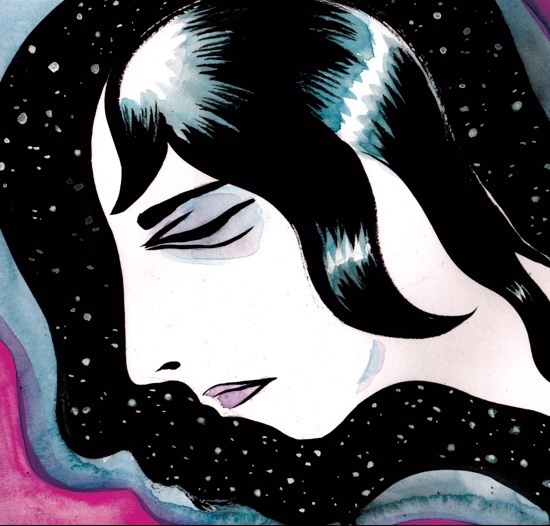So, it’s 2017 and exciting times await us all. Obviously, I’m talking about all the great comics that are coming out, and here are some of them. Actually, most of these date from 2016, but that’s what you get in a January round-up. We’ll try to do a little better soon, but I daresay quite a few of next month’s books will be late 2016 too.
Leela Corman – We All Wish For Deadly Force
(Retrofit)
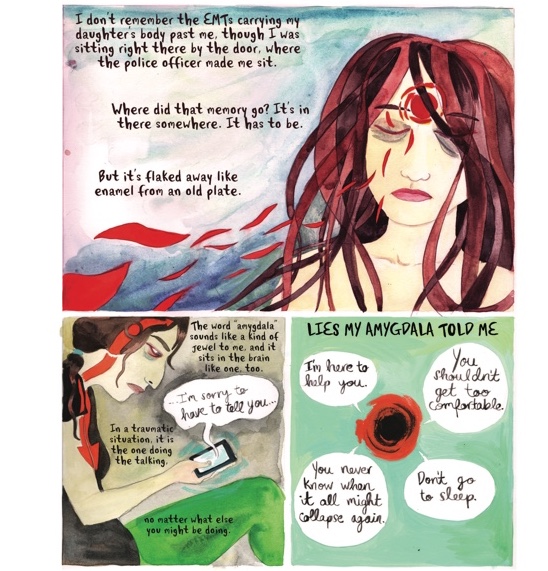
We All Wish For Deadly Force collects several of Leela Corman’s shorter works, previously published online on various sites. It’s an entirely coherent book, nonetheless, with common themes emerging. The first piece here is utterly devastating, dealing with the emotional fallout and PTSD resulting from the death of a child. As a parent, this simply rang true. Great art presents truth, and that is what we have here. If anyone ever dismisses comics as a medium, here is the story that refutes. The combination of the visual and literary works in perfect symbiosis here, each bringing something the other cannot and combining to show how profound comics can be. It’s one of the most powerful things I’ve read, and the book is worth buying for this alone.
The tragedy of her daughter’s death can be felt on almost every page, as one might expect, combined with a guilt about being privileged enough to lead an artist’s life while her family survived the Holocaust. Jewish culture and Corman’s own heritage feature heavily here, as does belly dancing, Egypt, and the treatment of women (belly dancers in particular) there. It’s an eclectic, unique and fascinating mix.
There is considerable variety in the artistic styles used. Some pieces are black and white, a few have a sketchbook feel, while others have a luxurious watercolour palette not unlike that used by Brecht Evens. This is combined with beautiful lettering, and all the stories feature women with a clear expression of fierce individuality.
Corman looks inward but reflects what she finds outwards, and her work is as enjoyable to read as it is to look at. This is a superb collection, very much recommended. Pete Redrup
Liam Cobb – The Fever Closing
(Breakdown Press)
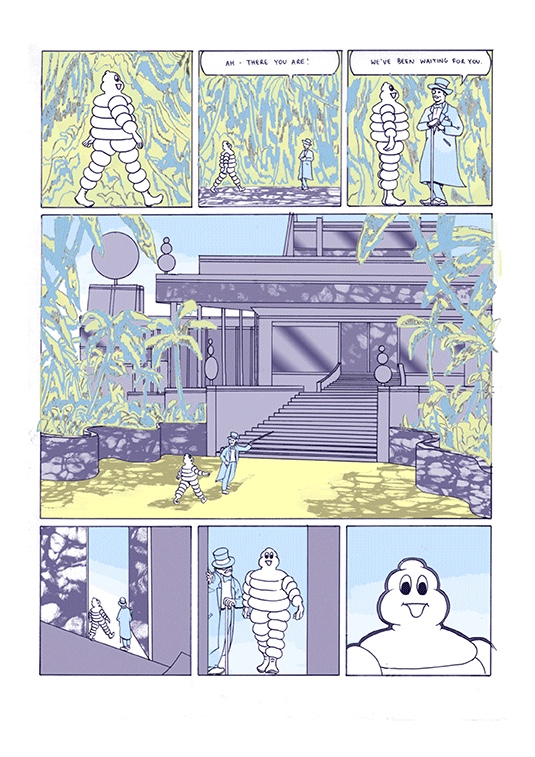
I first encountered Liam Cobb’s work at ELCAF last year, picking up Bastard Building because of its excellent title and finding that the contents more than lived up to the promise of the name. What I didn’t grab was a copy of Shampoo, which won the Audience Award. I was able to rectify this at Safari Festival, where I also got the brilliant and somewhat appalling Green Graves. If you’ve read it, you’ll know what I mean – the thought of those maggots actually makes me queasy. The Fever Closing is his first book for Breakdown Press, and whilst larger than his self-published comics from 2016, continues many of the same themes (jungles, parties, Pushwagneresque buildings with very deep perspective), and is once again riso printed.
Set on an exotic island, a man arrives by boat to attend a party. He suffers a series of petty indignities, and once he dons his Michelin Man costume there is a running gag whereby he is repeatedly misidentified. At the party he finds the guests are all dressed normally, although one tells him they are all in fancy dress, and he discovers he’s the guest of honour. Some of what happens next may be what you’d imagine would happen to a guest of honour, but some is definitely not.
The ending is bleak, though positively uplifting compared to Green Graves. Cobb produced consistently strong work in 2016 – pared back, effective storytelling, superb illustrations and a distinctive aesthetic aided by the use of risograph printing. Hopefully working with Breakdown will mean that his work is easier to come by, and I’m excited to see what he will produce this year. Pete Redrup
Robin William Scott – Every Life I Ever Lived Vol.1
(Good Comics)
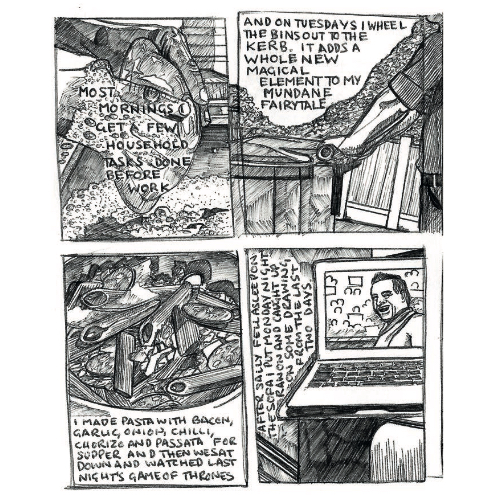
Autobiographical work can be challenging to make interesting, especially if it’s as long as this, which despite its compact size includes a hundred strips. Not every life is full of dramatic events, new places and moments of transformation. If the focus is on the relatively mundane – sleeping, eating, working and relaxing – then it takes real skill to spin an interesting narrative out of the undramatic. Robin Williams Scott manages this through repetition, a sort of Krautrock groove emerging that propels us through the pages and then suddenly drops something beautiful and honest into our laps to startle us, before the pattern picks up again and takes us on.
He uses a simple format: typically four panels, drawn in biro, each page an account of one day. Despite the throwaway implement, his images are carefully drawn and crosshatched. The full caps text rendered with all the imperfections of cheap biro boosts the impression that these are just everyday occurrences, not chosen for profundity but as a simple account of what happened that day. Sometimes the text is squeezed into the speech bubble to the extent that words are concatenated and it takes a couple of reads to be sure of the meaning. We see a lot of sleeping (and failed sleeping due to feline intervention), eating, commuting, work, wrestling, American TV and comics reading and drawing.
As we read, an economy becomes apparent, the way he ensures every page stands up on its own – a beginning middle and an end despite only having three or four panels. Quiet meaning is often found, deftly conveyed with an oblique image. I was charmed by this excellent book which more than lives up to the name of the publisher, and was sorry to come to the end of it. Pete Redrup
Kim Clements – Rabbit Thoughts
(Self published)
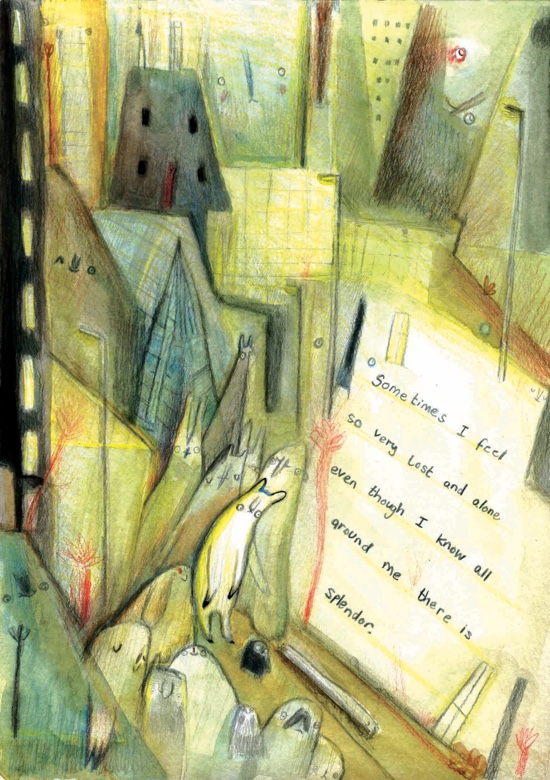
This is the first column of 2017 and here’s a comic from 2015. Had there been fewer books in my review pile I might have got this out in late 2016, but whatever year it currently is, this is well worth investigation. Rabbit Thoughts is Kim Clements’ first solo release, and it’s captivating. A tale of loneliness and isolation, the protagonist is a rabbit living alone in a big city. Clements uses an interesting narrative structure – like a poem, it’s more feelings than events. The text describes emotions, while the art shows different places and activities; through the changing mood and art there’s a clear sense of time progressing, even though it’s not obvious how long a period it covers.
There are no panels, but a series of single and double pages completely filled with one image. The complete lack of white space very effectively conveys feelings that are oppressive in scale, through huge, towering buildings, and looming people. The size of the images then work to convey unrestricted hopefulness towards the end. Colours are initially muted, but brighter shades emerge as the book progresses, with increasing amounts of red tones.
What stands out, apart from the wonderful art, is how the book is full of hope and positivity despite being about loneliness. The rabbit shows a real awareness of how one can sink into this, how sometimes it’s easier to withdraw than to get involved, even while aware that getting involved is exactly what might make one feel better. I don’t know to what extent if any this is autobiographical, but it feels both candid and insightful. This is quite simply a lovely comic, and you can pick up a copy from Clement’s website. Pete Redrup
Box Brown – Tetris
(SelfMadeHero)
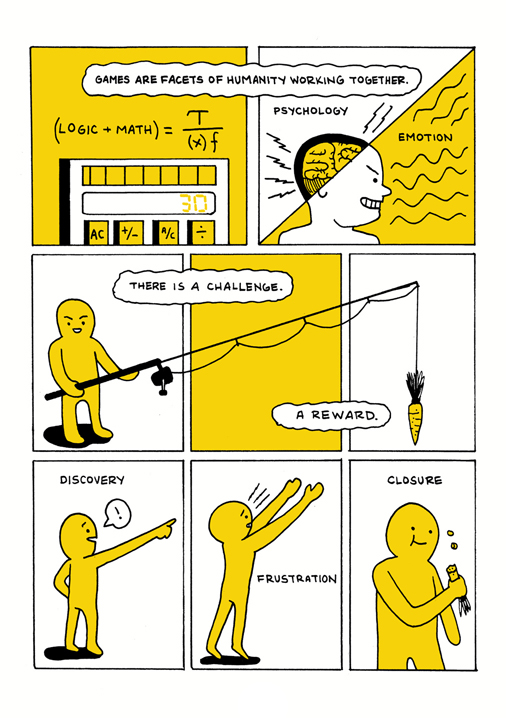
The history of Tetris is well documented. Indeed, the BBC’s From Russia With Love was a catalyst in Box Brown’s decision to write this. However, it’s also apparent that he has a long standing interest in video games, and this is one of the strengths of his new title. As well as providing an account of the story of this iconic game, he bookends it with some thoughts on the history and purpose of games themselves and some consideration of their significance as artistic and cultural artefact.
The tail end of the introductory section brings us to Japan in 1889 with the founding of Nintendo as a company making hand painted playing cards, and highlights the fascinating history of that company, always with a key focus on the individuals who pushed it forwards. As Nintendo releases one iconic product after another, Russian computer scientist Alexey Pajitnov starts to develop Tetrisin his spare time. What follows is the story of how the game spreads, is discovered outside Russia, and released worldwide through licensing arrangements of dubious legality. This is very much tied up with the fortunes of Atari and Nintendo as well as software houses owned by Robert Maxwell. I found this section required paying careful attention to names, as numerous parties worldwide are involved in complex negotiations and meetings as the rights issues are resolved. Once this completed the book follows the fortunes of the game’s authors and the winning publisher, Henk Rogers.
Brown keeps things visually simple with black and yellow artwork that includes occasional MS Paint-style artwork to achieve a pixelated effect. His style helps to soften the impact of meeting after meeting which might otherwise be a little dry. Overall, the reason this book works is that it offers more than just a history of the game – it’s what Box Brown brings through his passion as a gamer that rounds it off, and broadens the appeal to anyone interested in gaming as well as Tetris fans. Pete Redrup
Chesty Matt – Paid For It
(Kilgore Books)
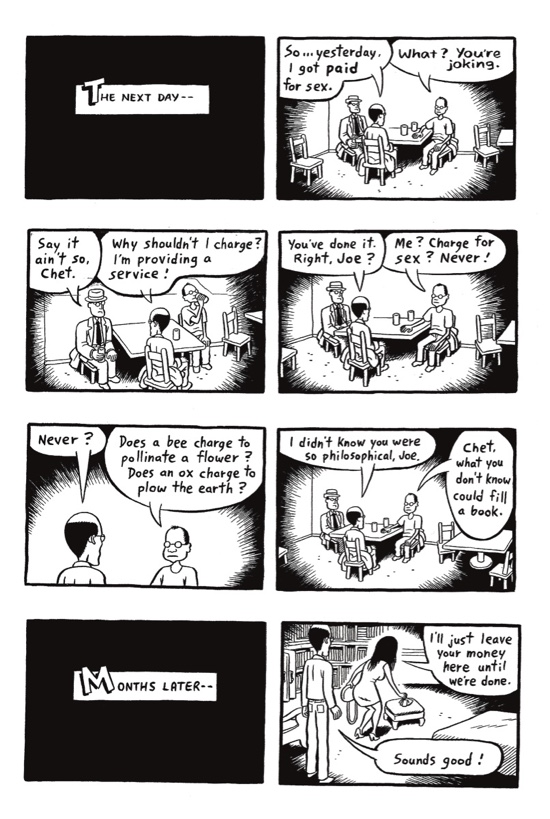
At first glance, Paid For It is that rarest and most exciting of things, new Joe Matt. However, before he sent me a copy, Kilgore Books publisher Dan Stafford was keen that I understood what I was asking for. In doing so, he was also kind enough to write my review for me:
"It’s an 8 page comic where he takes Chester’s art and rewords/reorders all of it. So it’s a ‘new’ Joe Matt comic, but it’s not a new ‘Joe Matt’ comic, if that makes sense. It’s a gag, a one-off, a knee-slapper, not a return-to-form for Joe. So reviewing it is kind of like, ‘This is really funny! Boy I wish Joe would make real comics again’."
This is entirely true. Matt has taken panels from Chester Brown’s controversial Paying For It (in which Brown recounts his visits to sex workers and develops his thesis for their rights) and repurposed them to show Brown as a male prostitute. For fans of the source material it is extremely funny. If you’re not already a Chester Brown or Joe Matt fan, however, this is not the place to start – it’s pretty self-referential, and the on-page dynamic between Brown, Matt and Seth is long established elsewhere.
If you’re putting in an order from Kilgore, you should add it at just $3 – it’s definitely worth that, but I’m not sure I’d want to pay international shipping for this alone. This is really funny! Boy I wish Joe would make real comics again. Pete Redrup
Hannah Eaton – Naming Monsters
(Myriad Editions)
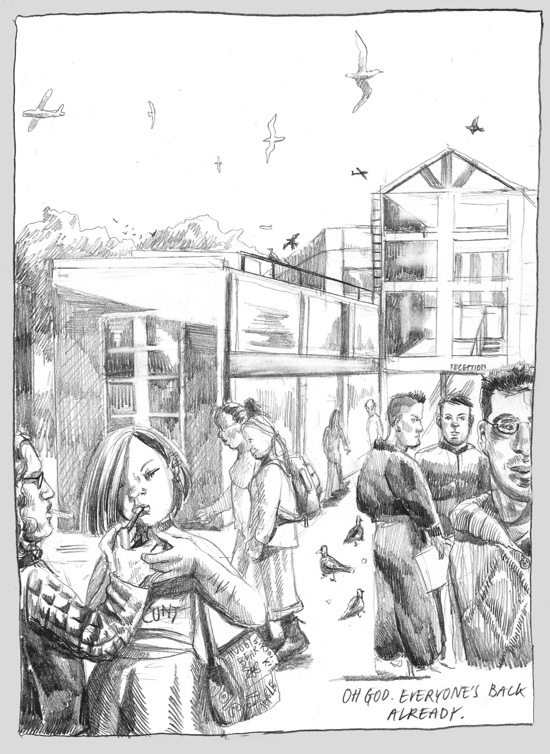
Although this came out in 2013, I picked it up after seeing Eaton speak at a Laydeez Do Comics event back in November and then read it just after I submitted my best of 2016 top 3 for this column. If I’d read it before it probably would have made it in because this is a beautiful comic. Visually it is clumsy in places where in this debut graphic novel the artist over reaches a little in the depth and framing of her scenes, but the structure of the story is flawless and the poignant combination of text and imagery is breath-taking in places, capturing mundane moments that sit within the tensely wound space of the narrative with a heartbreakingly honest depth. The story is familiar, coming of age while dealing with grief and exam results, but that makes it very easy to empathise with protagonist Fran’s fragile grip on the last few days of her summer of denial. To distract herself from her own fears and loss, she obsessively catalogues mythical monsters, mainly from Celtic folklore but with a few international characters thrown in. These stories are separated from the main narrative by a difference in drawing style and medium, the scratchy ink of the monstrous segments compared to the soft pencil of the ‘real life’ segments seeming to suggest that these in their way are more real than the teenage girl’s experiences. But of course as the book goes on the styles as well as the perspectives of the two begin to intertwine, including a third painterly style reserved for dream sequence, leading to a satisfyingly cathartic conclusion. Not one for younger readers as graphic sex and horror imagery is here, but what tale of a 16 year old’s life would feel real without that? Jenny Robins
Max Andersson – The Excavation
(Fantagraphics)
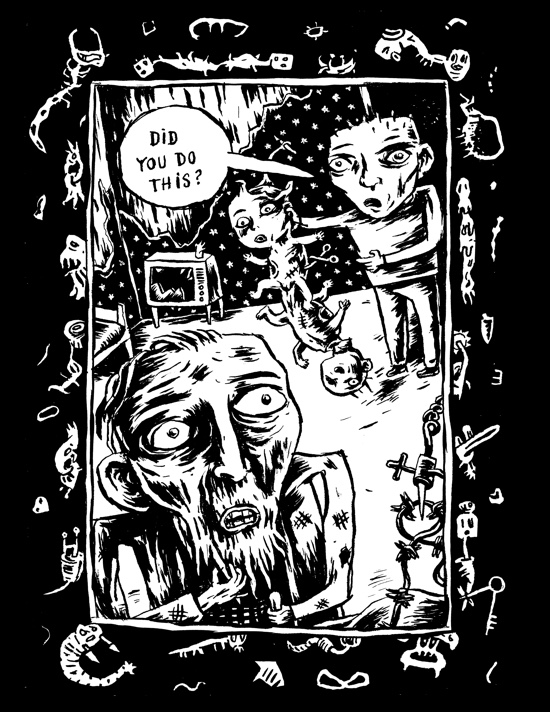
At first glance I thought the 382 pages of The Excavation by Max Andersson would take me a full day to read, but when I opened the book, and discovered that each page is only a single panel, the reading experience became as frenetic as the art itself, and I finished in less than an hour. Part of the speed at which this book was consumed was also a desire to escape Andersson’s world as quickly as possible, not because of any weakness in the story, but because of its authentically frightening and uncomfortable atmosphere. This is due to the fact that the book is based on the author’s dreams, creating a wind-in-your-hair wild ride reminiscent of the stream of consciousness grotesquery of William Burroughs’ Naked Lunch.
The story begins with a nameless couple attempting to visit the man’s family only to discover that his childhood home has sunken underground. After entering an archaeological excavation and paying admission to the man’s own subterranean abode, the couple finds his father stitching together his brother, and his mother transformed into a conjoined twin. The couple quickly departs, but the trouble with reopening the past is its desire to follow you afterwards. The man and his girlfriend return home, but a ring of the doorbell reveals, his putty-faced father, his rapidly aging mother, his newly put together axe-wielding brother, and a corpse with a shattered face. If you thought no one had a more dysfunctional family than you, look no further.
The Excavation is a book always on the go with a relentless momentum. The slashing ink lines are used to reinforce the violence and explosive energy of the work, and it looks as if Andersson put pen to paper as quickly as possible in order to capture the essence of pure manic anxiety. In fact, I would say the book seems more focused with creating an immersive emotional experience than with telling a structured narrative. If you prefer more linear storytelling then this book probably won’t be for you, but I believe taking part in the story’s raw expressive energy is reason enough to read The Excavation at least once. If you enjoy work inspired by dreams, but want a more cohesive story, then I strongly recommend Andersson’s first book, Pixy, which better curates his visceral imagination into a more streamlined sequence of events. Matthew Laiosa
Paco Roca – The Lighthouse
(NBM)
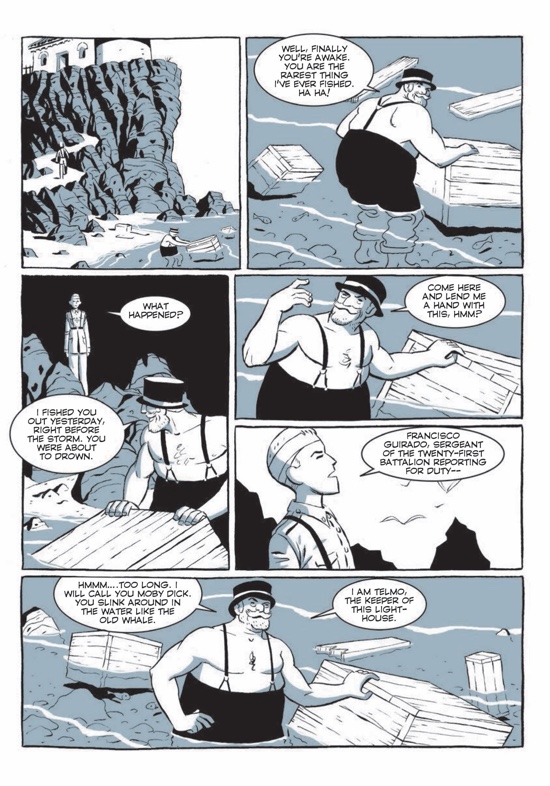
Paco Roca is quickly proving himself as one of the most gifted creators in comics. Last year his work debuted in the U.S. with the award winning Wrinkles, and 2017 already proves to be an excellent year for quality comics with Roca’s second work of full-length graphic fiction, The Lighthouse. If the rest of Roca’s body of work is as strong as these two releases, then I hope more publishers will continue to translate these foreign gems.
The book follows Francisco, a rifleman in the Republican army attempting to escape from the Fascists through France during the Spanish Civil War. Unfortunately, he quickly learns from another soldier that escape is impossible since the French are placing Spanish refugees in concentration camps. Before Francisco even has a chance to decide between the approaching army or the French camps, gunfire chases him over a cliff. After waking from his fall, Francisco discovers himself in the care of Telmo, the operator of a lightless lighthouse. Wallowing in defeat and hopelessness Francisco loses all motivation, but Telmo’s tales of adventure and the possibility of freedom at the nearby island of Laputa inspire Francisco to help in the construction of a boat. The two characters share stories of their past while collecting material for the boat including wood and velvet from the coffins of a capsized military ship, reminding us that death is never far away. When the time comes to begin their voyage towards paradise a new discovery is made, forcing both characters to face reality while simultaneously following their dreams.
There is nothing fancy about Roca’s artwork, but that is in no way meant to be a criticism. The art is a tool for the storytelling, and therefore doesn’t need to distract the viewer with busy lines or complicated colour schemes. The simple shapes, heavy blacks, and monochromatic use of blue are used as succinctly as the story they illustrate, making this a work of visual poetry, transporting the reader to the quiet solitude of a lighthouse’s beach.
This is the second of Roca’s books about finding hope amidst hopelessness. In Wrinkles two men find friendship in the terminal world of assisted living, and in The Lighthouse Telmo helps Francisco find purpose and imagination in the face of total defeat. At the start of a new year, and in the wake of political disappointment, Roca’s books are a good way to begin with a positive attitude. Matthew Laiosa
Santiago Garcia & David Rubin – Beowulf
(Image Comics)
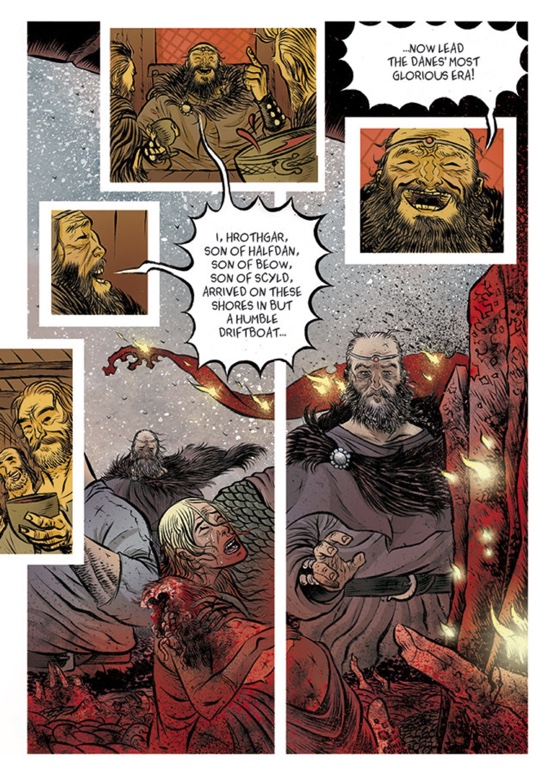
Beowulf is a mostly faithful adaptation of the classic poem about the quest for immortality through acts of epic heroism. For those unfamiliar with the centuries-old legend, the story centres on the Geat hero Beowulf, and his attempt to save the Danes from Grendel’s twelve-year campaign of dismemberment. No mortal weapon can harm the creature so Beowulf chooses to face Grendel completely unarmed and unclothed, a decision that even the monster finds arousing. Beowulf mortally wounds Grendel by tearing off its arm, but before anyone can rejoice too heartily, a second creature, Grendel’s mother, terrorizes the Danes once more. Journeying to the creature’s lair, Beowulf fights and defeats his second foe, after which the story jumps fifty years forward where a bored Beowulf, made king of the Geats, yearns for another chance to prove his valour. He finally gets his wish when a slave steals treasure from a dragon, granting Beowulf the eternal glory he desires.
It is no surprise that David Rubin has made a seamless transition from European comics into the American mainstream. His work evokes the energy of Paul Pope’s animated ink splatters, which is probably why he was selected to illustrate Pope’s The Rise of Aurora West. For the most part, Rubin’s style works well in Beowulf, and his designs for the monsters are unique and distinctive. However, some of his layouts and overuse of texture make the work a little hard to read. On some pages Rubin litters the compositions with micro-panel close-ups of gore, sword hilts, clenched fists, glaring eyeballs, gnashing teeth, and ‘monster vision,’ which is aesthetically interesting, but tends to clutter. The same can be said of the digital colouring filled with snow, dirt, and blood, often muddling everything together in a cacophony of visual noise.
Garcia’s adaptation of the story feels faithful and respectful of the source material; I only wished more of the lyricism of the original text could have been preserved like Pablo Auladell’s masterful adaptation of Paradise Lost. However, I’m sure not being limited by the original language gave Garcia more freedom to tell the story in his own way. Overall Beowulf is an entertaining read, but could have been improved with more controlled artwork, and additional moments of quiet reflection to contrast with the hacking, slashing, spurting, and spewing. Matthew Laiosa
Moebius – The World Of Edena
(Dark Horse)
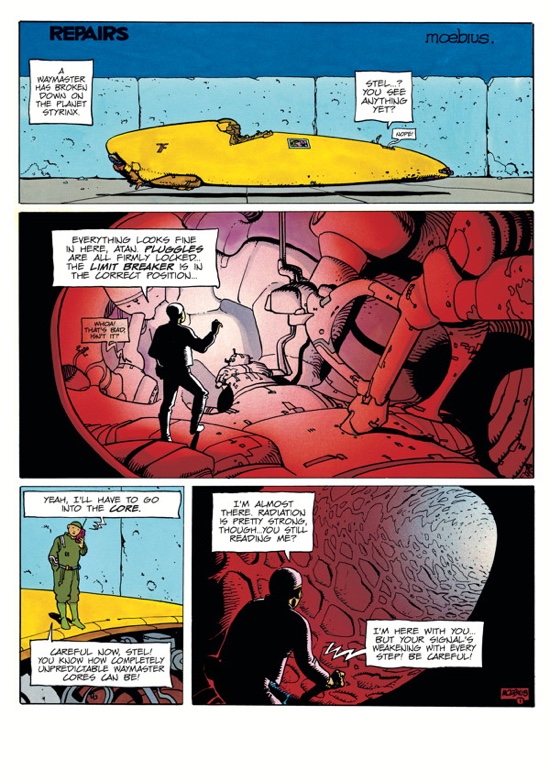
Let’s get the easy bit out of the way first – this book is beautiful. For the first time, in English, all Moebius’ stories that, roughly, deal with his World of Edena. A brief essay at the beginning of the book describes them as being a cycle, which were, amazingly, born out of a promotional short story written for use in an internal Citroen (yes, the car company) document.
The stories are complex tales of science fiction. The world begins with a short story called Repairs. Two Mekaniks, Stel and Atan, repair flying machines called Waymasters – ships that have a personality or consciousness that pilots them (think something akin to Iain M. Banks’ ships from the Culture series). Stel finds himself deep in the engine of a broken down Waymaster. He gets captured by the energy in its core and “transported" back to his childhood and an occasion when his toy submarine breaks. Upon helping himself to repair the toy, the Waymaster also becomes repaired. The Paymaster commends Stel on the purity of his heart and how this has aided him in this work. The Goddess is something else entirely. Featuring Stel and Atan (recurring characters in most of these stories), what’s real or imagined, what’s taking place now, or in the future, or what’s being revealed deep within the characters, or just some drug addled state, are all posed during the story. It’s taken multiple readings to figure out the different stands of the story that he joyously throws together. There’s such a strong French new wave style and vibe to them that it’s impossible not to get lost in this mesmerising world, completely submerged in Moebius’ imagination.
Moebius’ style has always been breathtaking. With Edena, the worlds are created from a mix of high tech and high nature: deep, plush forests cover massive planets, but fall away to reveal epic cities with high rise buildings and horizon-less hallways. The style is psychedelic without being garish, and perfectly reflects how alien the worlds are. Whilst drawing these stories, Moebius used a clean line style where minimal details are used. It’s amazing how much is conveyed with such a simple approach.
Whilst the style really shines out, it never diverts from the content – the stories always poise intriguing questions. The topics are strongly placed in the stories and can dwell on matters of sexuality (characters who might be masculine or feminine, but never referred to as such), health (diet and exercise feature heavily as important cornerstones of life) or society (the regular battles between good & evil and dictatorial societies). The book rewards many re-readings, and numerous times additional strands of interest have revealed themselves as I’ve gone back to admire the artwork again.
This is such a great collection of work. Ultimate kudos to Dark Horse Comics for collating it, finally, into a single volume. If you have any interest in graphic novels and comics, this is essential reading. Rich Hughes

